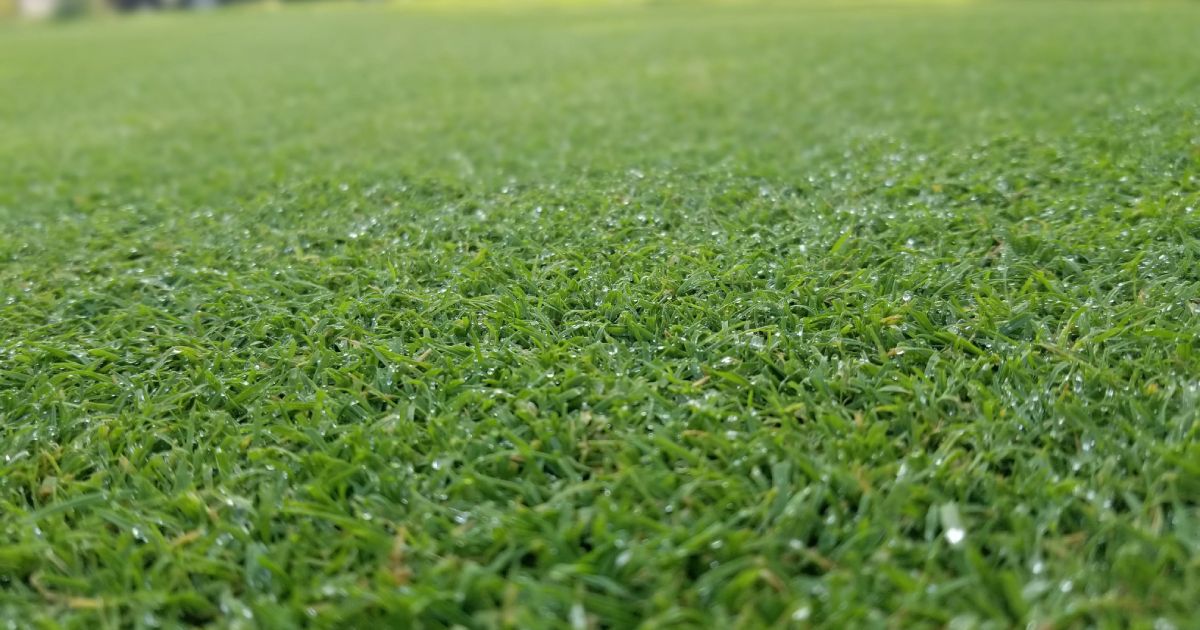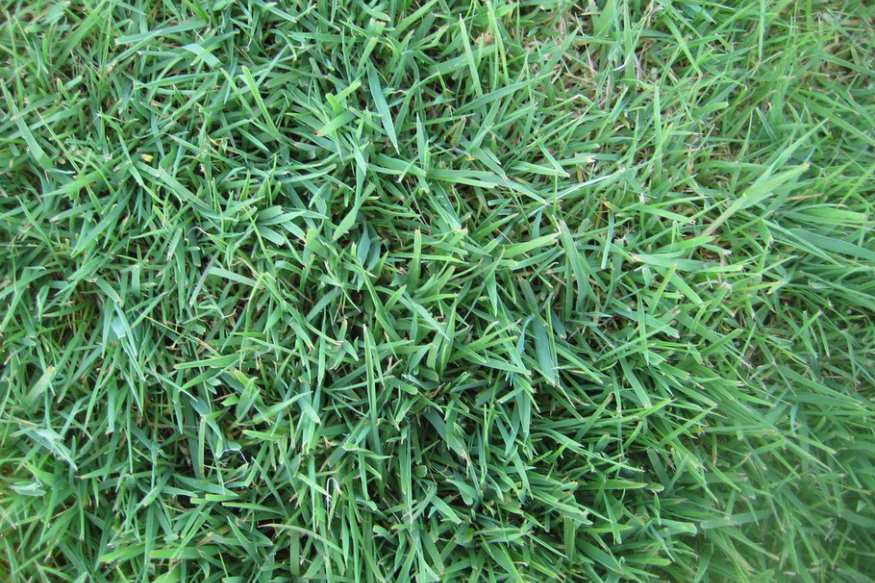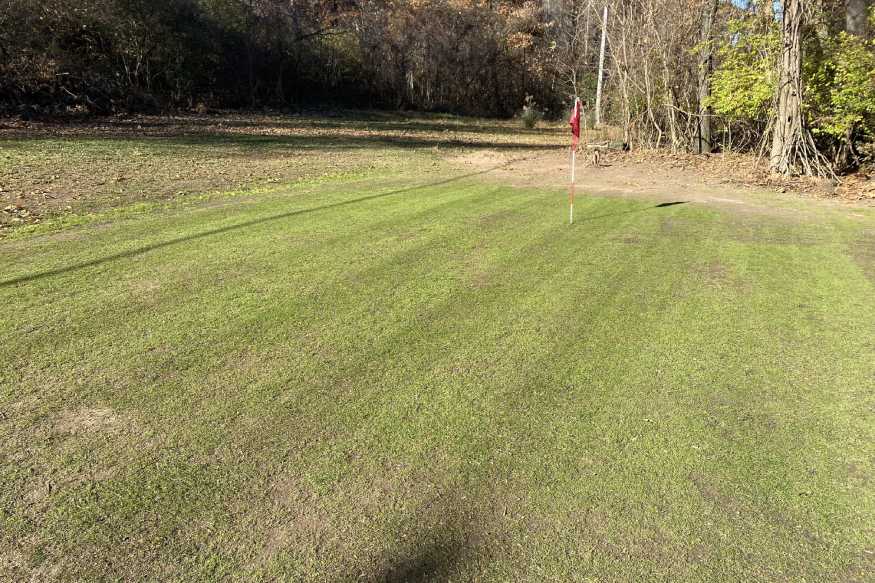For athletes and golf aficionados, bent grass is a wonderful turf grass that makes for the perfect athletic fields and greens. But for most homeowners, bentgrass is a nightmare. Its “puffy” growing habit and brown appearance make it highly undesirable as a lawn turfgrass.
In this guide, we’ll look at what it takes to care for bent grass on your home putting green as well as what it takes to eradicate it from your lawn. To make things easier, we’ve included our lawn care calendar with care and eradication tips by the season.
Bentgrass Overview
| Also Known As | Creeping bentgrass; Agrostis palustris |
| Type of Grass | Cool season perennial |
| Optimal Zones | Golf courses and athletic fields in northern zones |
| Root Structure | Shallow, mat forming |
| Winter Hardiness | Excellent |
| Heat Tolerance | Fair to good |
| Shade Tolerance | Good |
| Water Requirements | High |
| Drought Tolerance | Poor |
| Self Repair Capacity | Good |
| Overall Maintenance Requirements | High |
The History of Bentgrass
The first bentgrass species arrived in North America along with the first colonists. It was widely used in turf grass mixes from South Germany. Creeping bentgrass is native to Eurasia and Northern Africa.
North America has its own native bentgrasses, including seaside bentgrass, which became popular for turf use in the 1920s. Most bentgrasses readily hybridize, giving rise to new variations as different species are intermixed. Because of this, many cultivators of bentgrass were created and refined through the 20th century.
Bentgrass remained popular as a lawn turfgrass through the 1960s. It fell out of favor when traditional bed knife mowers were replaced by rotary mowers. These types of mowers tend to pull bentgrass stolons out of the ground, causing puffy growth habits and an undesirable patchy brown coloration.
Today, bentgrass is used almost exclusively on golf courses and athletic fields. Here, maintenance crews can afford to provide the kind of care required to make bentgrass look great and function the way it should.
Mark Yang, founder of Golf Leap, told us that, “bent grass in your backyard can be transformed into your very own putting green. Though, creating and maintaining this green can become a second full time job!”
Unfortunately, bentgrass remains a common feature in many home lawns as an invasive weed. Its horizontal growth habit makes it incredibly difficult to remove. And it often finds its way into yards from neighboring athletic fields and in contaminated seed mixes.
Bentgrass Characteristics
Keeping bentgrass thriving on greens and athletic fields takes a great deal of work. This is surprising considering how much work it also takes to get rid of it once it infiltrates your lawn.
Whether you’re looking to remove bentgrass or help it thrive, understanding the characteristics of this turf species will help.
Type of Grass
Bentgrasses are all perennial cool-season grasses. “Perennial” meaning they come back every spring. And “cool season” meaning they do most of their growing when temperatures are below 75 degrees.
Like Kentucky bluegrass, ryegrass, and fescues, bentgrass grows the most in the spring and fall. In mild climates, it can grow throughout the summer and winter as well.
Optimal Zones
Creeping bentgrass is used on courses and fields throughout the northern zones. Because of its advantages as a greens grass, it is frequently used on golf courses into southern transition zones. But keeping it healthy in these areas during the summer takes work.
As an invasive weed, bentgrass is very common in the north and can be found torturing homeowners well into transition zones.
Root Structure
Bentgrass roots are very shallow and tend to form thick mats. This is one reason it is incredibly hard to remove from established lawns. It is also why bentgrass fields require constant watering and care.
The roots of this grass grow from stolons on the soil surface. When these stolons are pulled and lifted away from the soil by rotary mowers, they begin developing leaves instead. This is what causes the “puffy” brown spots that homeowners dread.
Winter Hardiness
Bentgrass is the most cold hardy of all cool-season grasses. It will succumb if uncovered during extreme cold snaps but generally survives well, especially under snow cover.
When nighttime temperatures drop below 50 degrees, bentgrass turns reddish brown and goes dormant.
Heat Tolerance
Naturalized bentgrass has a low heat tolerance. In southern climates, it will typically die off completely in the summer.
But many cultivators have been selected for their heat tolerance. These varieties are used on golf courses in transition zones and account for some of the invasive bentgrasses found in yards.
Shade Tolerance
Bentgrass is well tolerant of shade under normal growing conditions. However, on golf courses where it is subjected to very low cutting heights, it grows much better in full sun. As a weed, you are just as likely to find it in full sun as in full shade.
Water Requirements & Drought Tolerance
Bentgrass requires as much, if not more, water than most cool-season grass species. But because it has such a shallow root system and forms dense root mats, getting it enough water can be tricky. This is why many golf courses water their greens multiple times per day, especially in the summer.
For the homeowner looking to eradicate bentgrass, you can use drought periods to your advantage. By withholding water in the hot summer, you can often kill off bentgrass rather easily. This is especially effective if your lawn consists of drought-tolerant fescue.
Self Repair Capacity
Bentgrass has a low tolerance for wear, especially when cut short. At longer lengths, as is typical on athletic fields, it holds up fairly well. And it has a good capacity for self-repair when given the right conditions to thrive.
Bentgrass Lawn Care and Eradication Calendar
Caring for a bentgrass home putting greens requires year-round maintenance.
For new installments, seed at a rate of 1 to 2 pounds per 1,000 square feet in the fall. Spring seeding is also possible in northern climates. Seedlings take about 2 weeks to germinate.
Once the seedlings have reached 2 inches in height, you can begin following our bentgrass lawn maintenance plan, below.
To eradicate bentgrass from your lawn, you should work to ensure your lawn is as healthy as possible. Reference our species-specific lawn care guides for help here. In the meantime, we’ve also provided some eradication tips on the calendar below to help rid lawns of invasive bentgrasses.
Spring Care
Bentgrass grows the most in the spring. Because of this, you’ll have to do the most maintenance this time of the year, whether you are cultivating or eradicating bentgrass.
Mowing
Bentgrass grows best at heights between ⅛ and ½ inch.
Cutting should be done with a sharp bed knife manual push mower.
In spring, shoot to mow your green every day if possible.
Eradication: For lawns suffering from bentgrass invasion, set the mower height to the optimal height for your primary grass species. Your rotary mower will pull up bentgrass stolons and exacerbate the problem of puffy growth habits. To counteract this, walk back over your lawn after mowing and manually pull out any stolons you find sticking up.
Fertilization
Bentgrass can survive well under low nitrogen conditions, however, for greens use, monthly fertilization is advised. Shoot for a ratio of 6-1-4-4 for nitrogen-phosphorus-potassium-sulfur throughout the year. Fertilize at a rate of ¼ to ½ pound per 1,000 square feet per growing month.
Eradication: Because bentgrass can survive low nutrient conditions, it is best to fertilize your lawn according to your primary species. Healthier lawns will better outcompete bentgrass.
Weed Control
Manual weed control is the best approach for bentgrass lawns. If you do go the chemical route, be sure to choose only treatments approved for sensitive grasses like bentgrass.
Eradication: Most herbicides that target bentgrass will also kill your primary grass. Since you have to spray it at least a foot out from active growth to kill roots, this can be problematic. Some herbicides, like Torocity and Tenacity, will kill bentgrass but not other common cool-season grasses.
Watering
Additional watering is typically not needed in the spring. For drier and warmer climates, you may need to begin supplemental watering in May. Aim for 1 inch of moisture per week applied in short daily watering sessions.
Pest and Disease Control
Bentgrass is prone to many funguses and diseases, including:
- Dollar spot
- Brown patch
- Pythium
- Take all patch
- Fusarium patch
- Gray snowmold
- Yellow patch
- Leaf blight
- Red thread
Many of these can be avoided by providing proper sulfur fertilization. Keep an eye out for signs of problems and treat with targeted treatments only when needed.
Bentgrass is not overly prone to insect infestation.
Dethatching
Bentgrass is prone to thatch overgrowth. On sandy soils, thatch can build up at a rate of ½ inch per year. Aggressive dethatching should be done in the spring during peak growth periods.
Eradication: The thatch bentgrass creates can be detrimental to your primary lawn grass. Detaching bentgrass overgrown areas should be done in summer to resolve thatch problems and help stress bentgrass to retard growth.
Summer Care
To maintain a healthy green through the hotter months, you will have to provide extra water, ventilation, and fertilization. This is also a good time of year to target invasive bentgrass while it is heat stressed.
Mowing
Continue mowing as you did in the spring. If adequate irrigation is not provided, mowing may be needed only every other day.
Watering
In most climates, irrigation will need to be slowly increased to 1 3/4 inches per week as temperatures increase. Apply this moisture in multiple short watering bouts per day.
Eradication: Bentgrass is not drought tolerant. If your primary grass species is relatively hardy (fescue or perennial ryegrass), restrict water throughout the summer to help kill off bentgrass. Restricting waterings to 1 inch every three weeks, applied in two or three deep sessions, should keep primary grass from dying.
Aeration
Bentgrass greens will require special aeration in the summer to increase ventilation and decrease heat stress. Aerating shoes are a great option for aerating greens without disrupting play.
Pests Control
Continue using targeting pest and disease control methods as needed.
Fertilization
Continue fertilizing as you did in spring.
Fall/Autumn Care
As temperatures cool, bentgrass will begin growing more vigorously. For home greens, this means more frequent maintenance. For lawns, this is the time to find out if your summer eradication methods worked and to continue supporting primary grass growth.
Mowing
Continue mowing as you did in the spring. As growth increases, return to mowing every day.
Fertilization
Continue fertilizing as you did in spring.
Eradication: Soil testing in the fall can help determine what your primary grass needs to outperform bentgrass. Fertilize according to your results in September and again in early November. You should also apply a special winterizer fertilizer during this time to help support primary grass through the winter months.
Weed Control
Continue using manual weed control methods for bentgrass lawns. Applying a broadleaf herbicide approved for bentgrass this time of year can help with dandelion growth in the spring.
Eradication: Continue applying targeted herbicides to kill off bentgrass as needed.
Watering
As temperatures drop, reduce irrigation to 1 inch of moisture per week. Apply in multiple daily sessions. As winter approaches, reduce to single daily sessions if natural rainfall is not enough.
Keep an eye on precipitation accumulation after your irrigation system has been winterized. If it’s a dry fall, you may want to hand water to keep the grass green.
Pest Control
Continue using targeting pest and disease control methods as needed.
Aerating and Dethatching
Now is the right time to do a second bout of aggressive dethatching for bentgrass greens. For serious hobbyists, it may be worth looking into a greens-grade dethatcher.
Note: Full core aeration may also be necessary this time of year to break up thatch. This can be disruptive to greens use, so consider this when scheduling.
Eradication: Fall is a great time to have your lawn aerated to avoid compact soil. Aerated soil is better able to accept nutrients and water, which will help primary grasses outperform bentgrass.
Overseeding
Fall is the best time to overseed your lawn, if needed. This isn’t typically necessary with bentgrass greens unless they suffered over the summer. If so, spread seed at least 45 days before the first frost to allow new seedlings to establish.
Eradication: If you’ve had some success against bentgrass over the summer, now is the time to overseed these areas with desirable grasses. Spread Kentucky bluegrass, perennial ryegrass, or tall fescue at least 45 days before the first frost.
Winter Care
In most climates, bentgrass will go dormant during the cold winter months. It is very hardy and needs little maintenance or care this time of year. For those looking to eradicate, now is the time to rest and establish a game plan for getting rid of bentgrass if it comes back next year.
Watering
Watering is typically not needed in the winter. But, if you are experiencing a particularly dry cold season, you may have to hand water on occasion. Shoot for about ½ inch of moisture every week or two when temperatures are above freezing.
Overseeding
If you missed your window to overseed in the fall, you can do so in late winter. The best time to do this is February when the ground is still moving through thaw and freeze cycles. This will help pull the seed into the soil.
Eradication: The same is true if you missed your chance to overseed desirable grass in the fall. This time of year is perfect for spreading cool-season grasses, including fine fescue, tall fescue, Kentucky bluegrass, and more. The seeds will begin to sprout just as your mature grass starts to green up in the spring.



I live on a golf course with bent grass putting greens in Cary, NC. About three years ago I saw the first signs of bent show up in my yard. First in the mostly shady back, then in the more sunny front. Obviously, I struggle to grow fescue and other similar grasses in the back area and more or less welcomed the bent as I do moss., but out front the fescue and rye mixes did well. Move forward to today. I have been encouraging the bent to thrive. Not only has it taken over about 60% of the back yard, but now is well established in the front. Despite my plant zone, the bent does very well. Yes, a bit more water, but it has not shown any signs of dying back due to the summer heat. In fact, lawn areas under my southern pines are thriving where the fescue always struggles. I did do a little over seeding with creeping bent last fall and it has produced good results.
My goal is to get the whole yard mostly creeping bent and keep it cut to 1 inch. Any recommendations?
can I plant bent grass between flag stones on a patio in Ohio?
Yes, you can plant bentgrass between flagstones on a patio in Ohio. However, it requires high maintenance, including frequent watering and mowing. It’s a cool-season grass that might struggle in Ohio’s hot summers. Also, it has a low tolerance for wear, so it might not hold up well in high-traffic areas. You might find this article on grass selection for Ohio useful.